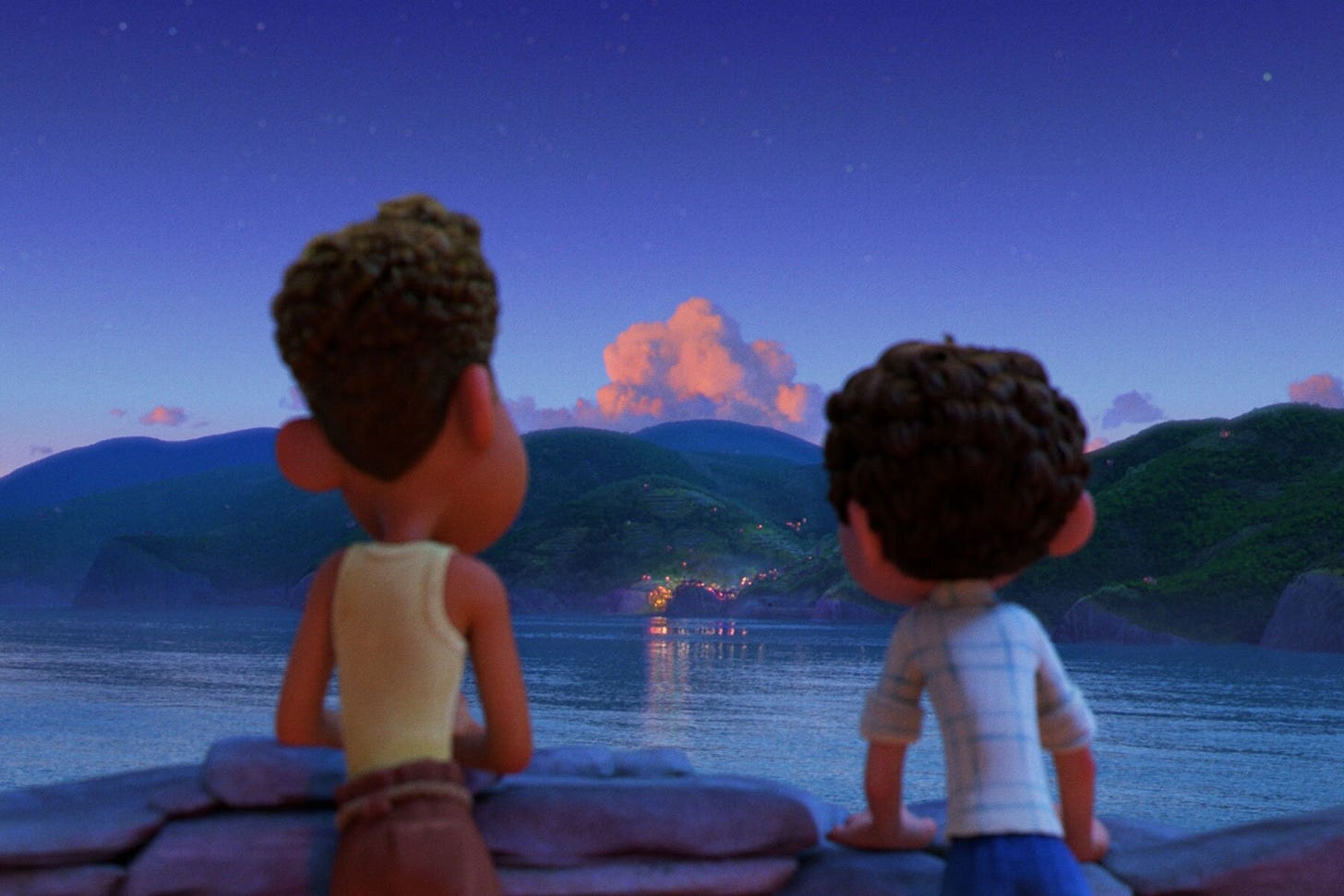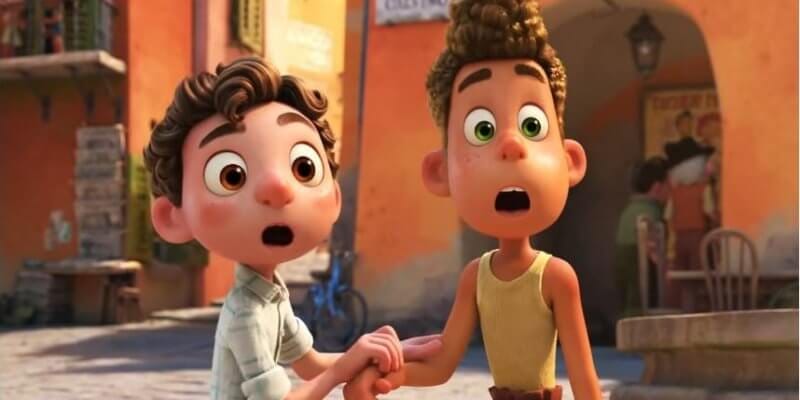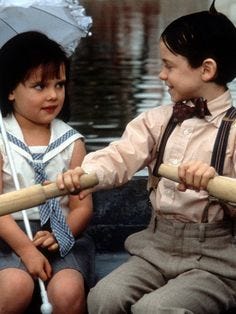Arguing that Luca and Alberto’s relationship can only be understood as gay reinforces the damaging patriarchal conception of boyhood masculinity. Some insisted that Luca and Alberto are obviously gay since they embrace one another, exchange emotionally intimate moments, and plan to live together. (The boys figure the world will be theirs, if only they can get themselves a decent Vespa!)
Slate associate editor, Marissa Martinelli, observed that “[Luca and Alberto] have their share of moments that could be easily interpreted as puppy love, such as when they’re stargazing with their arms around each other… their secret time together is liberating for them. It’s also forbidden,” she pointed out.
“[T]heir relationship is very physically intimate for a friendship. They put their arms around each other. They watch the sunset. They're stargazing. It's a little bit romantic.”
Martinelli’s interpretation reminded me of this disheartening but astute observation by hooks: “Boys are not seen as lovable in patriarchal culture.” Though boy children undoubtedly possess unearned privilege that girls do not, hooks also noted, “status and even the rewards of privilege are not the same as being loved.”
In patriarchal culture, men receive praise and societal prizes for displays of power and usefulness—on the job, in athletics, and in the military. Past a young age, though, boys are frequently deprived of affection from parents out of not only homophobic concerns that the child might be “made gay”, but also out of concern that they develop the “necessary” toughness to endure a cold, fierce world. The notion that Alberto or Luca could only be loved by one another romantically reinforces that very patriarchal idea.

This line of interpretation reveals a potent cultural bias that narrows the vision of masculine humanity. Imagine if Luca and Alberto were two girls of the same age and circumstance who embrace one another, exchange emotionally intimate moments, and plan to live together. Would those details be sufficient to confidently deduce the sexuality of the two characters? Of course not. Human relationships and love are not so singularly-sexual or romantic in nature.
The presumption that men of all sexual orientations are incapable of non-sexual bonding with others…reinforces the dehumanizing patriarchal stereotype that men are naturally less emotionally capable and solely driven by sexual conquest rather than intimacy.
The difference is that, though romantic or erotic love dominants the media landscape, we do occasionally find representations of female philia, love between close friends who are not romantically involved. The absence of films centered on male friendship, without the sexist requisite of reckless partying and sexualization of women to offset accusations of homoeroticism, and other forms of loving relations ought to be recognized as a problem itself.
This is the second part of a two part exploration of masculinity in the Disney movie, Luca. Read part below
The presumption that men of all sexual orientations are incapable of non-sexual bonding with others, be they friends, family members, or children, reinforces the dehumanizing patriarchal stereotype that men are naturally less emotionally capable and solely driven by sexual conquest rather than intimacy. The lacuna in representations of healthy male philia makes movies like Luca all the more important since it has revealed underrecognized gendered biases in many of its viewers and gives us an opportunity to discuss boys and men’s humanity. The movie reminds us the importance of art in stirring the creative consciousness required to combat patriarchy in all of its insidious manifestations.
What’s Wrong with Insisting Luca Has to Be Gay
Some in social media claimed that Luca and Alberto must be gay since they are not like “typical” boys. But this claim only make sense if we accept the patriarchal conception of maleness, a definition that is as dehumanizing and misguided as the presumption that there is only one way to be a woman.

Though the two terms continue to be conflated, 20th century feminist philosophy identified the important distinction between sex and gender. Gender is a conceptual framework or worldview that imposes social-cultural meaning on the largely biologically-determined category of reproductive sex. To appreciate the difference, consider the way we attribute symbolic meaning to roses that are external to the rose itself. Giving a rose to someone is believed to be an expression of our love for them. Outside of such cultural beliefs around roses, a rose would be, well, just a rose.
The rose, in this example, is analogous to biological category of human sex, which refers to males (those possessing the primary reproductive organs, the testes) and females (those with ovaries). And the “love” meaning attributed to the rose is analogous to gender, the non-biologically determined lens that insists make-up, high-heels, and nail polish are for women and tree-climbing, adventure, and sports are for men.
It is helpful to replace the reductive and essentializing term “cisgender” with a recognition that there are a multiplicity of masculinities and femininities—countless ways to be a male or female in the world.
Patriarchally prescribed gender stereotypes attach narrow and stifling definitions and cultural meanings to our sex. Underlying this ideology is the strange presumption that our unique and unwieldy human essence can be determined, with clairvoyant certainty, simply by knowing something about our chromosomes or reproductive anatomy. The necessity of enforcing these dictated boundaries of “true” and “rightful” manhood and womanhood is a reminder that patriarchal gender is, indeed, a cultural construct purposed to dictate rather than accurately describe what it means to be a male or female bodied person.
It is helpful to replace the reductive and essentializing term “cisgender” with a recognition that there are a multiplicity of masculinities and femininities—countless ways to be a male or female in the world. To this point, not all gay boys or men exemplify media stereotypes of what is typically described as “effeminate” men. Some gay men are as rough-and-tumble as the poster-children for conventional heterosexual masculinity. And some heterosexual men are as disinclined to forceful, aggressive self-expression as are some gay men. The culturally dominant image of the gay man is a stereotype that conflates sexuality with personality and social character. The two, ultimately, are accidentally but not essentially related.
Another reason for the presumption that Luca and Alberto must be “in love” is due to a little-discussed cultural bias for romantic love over other expressions of love. Without overlooking their misogyny, endorsement of slavery, and embrace of violence, we can, nevertheless, appreciate that the Ancient Greeks recognized the diversity of love and the legitimacy of non-erotic love. In addition to eros, the Greeks recognized forms of love including philia, love between friends, agape, non-personal love of all in one's community, and storge, non-sexual care for others’ interests and welfare—familial love. We ought to be on the lookout for not only sexist and homophobic cultural biases, but also narrow conceptions of pivotal human ideas and experiences like love.
How Luca’s Boys Are Different
Rather than the usual media representations of “boys will be boys”—including abusive banter and teasing—Luca and Alberto are generally kind to and mutually respectful of one another. They take time out of adventure and play to reflect, talk about their emotions, and tenderly empathize with each other. Happily absent in the film are representations of meanness, cruelty, bullying masquerading as “play,” and bonding over putting girls down. The film’s one mean, cruel, misogynistic character is also its villain.
The timing and context of Luca and Alberto’s bonding is also important. Their friendship develops when Alberto is very vulnerable after his father’s disappearance. Before meeting Luca, Alberto was feeling isolated and abandoned; hurt and anger lurk beneath his exuberant exterior. In this sense, Alberto is like a lot of boys in society. “Many boys are angry,” hooks notes, “but no one really cares about this anger unless it leads to violent behavior. If boys take their rage and sit in front of a computer all day, never speaking, never relating, no one cares.” But they quickly get our attention—and often the wrong kind of validation—when they act out violently. Alberto’s fears of being unloved and abandoned do, at a pivotal point in the movie, erupt into a reckless confrontation with his human attackers following a falling out with Luca. But this rage is shown to be unproductive and unnecessary. Through the love of his friend and acceptance by a fisherman who had previously hunted the little-understood “sea-monsters,” Alberto regains his self-esteem and productively processes his feelings.
It’s also worth noting that Luca distinctly lacks romantic expressions between the children. This is itself worthy of applause since our media too often sexualizes girls and projects adult desires, impulses, and expectations onto children. This occurs when adults attribute a young boy’s interest in playing with a young girl as evidence of romantic interest. Parents commonly say that they are “boyfriend” and “girlfriend” or will “be together” in the future.
Such a projection is obviously heteronormative, which is to say the adults presume that everyone, including these children, are by necessity, heterosexual. Parents rarely presume two little boys are playing together because they are attracted to one another. (Perhaps the assumption is that there can be only one good reason for a boy and girl to want anything to do one another: romance. But how might such a belief block meaningful cooperation between men and women outside of romance?) The more general belief underlying such perception is that romantic interest is the singular drive of human bonding.
The 1994 movie, Little Rascals, exemplified this “adult gaze,” as some call it. The movie not only pits boys and girls against each other but also centers on a very young boy—around 6-years-old—wooing the “opposite sex” in the most stereotypical gendered fashion. On the one hand, the boy, Alfalfa, breaks with his explicitly “woman hating” boys club to pursue his love interest, Darla.
Alfalfa’s pursuit is done in secret, however, since he is threatened with shaming and bullying by his buddies for liking a girl. In the comedic spirit of the movie, Alfalfa’s friends follow and prank him in order to undermine his burgeoning relationship. Eventually Alfalfa and Darla are united and Alfalfa’s friends accept the relationship, but the underlying patriarchal idea remains: only through romantic love can the gulf between boys and girls be overcome. Luca offers us a very different vision of shared humanity.
Another Masculinity is Possible
Luca suggests that boys are not strictly motivated to outdo other boys or to prop up their egos by insulting girls. Indeed, Luca, in particular, forges a deep and non-romantic bond with the human girl, Giulia, who lives in Portorosso. (Giulia, a determined, assertive, and self-confident girl, defies patriarchal gender prescriptions.) The movie suggests that boys are not strictly motivated to out-do other boys or to prop-up their egos on the insults of girls. Instead, the message of the film is that boys can be as expert at caring for others as they can be at say, winning a race.
What makes Luca such a powerful expression of healthy and humane masculinity is that it suggests any boy—of whatever sexual identity or orientation—can be a caring, loving person. Luca and Alberto might go on to be in romantic relationships with other men, women, or both. (Or, with no one.) What the movie makes clear, though, is that boys do not need to wait for romance to form loving relationships with other people. And that is a capability we should all want our boys and men to develop.
❤️ Like,🔄 Share, and✊ Subscribe








<3